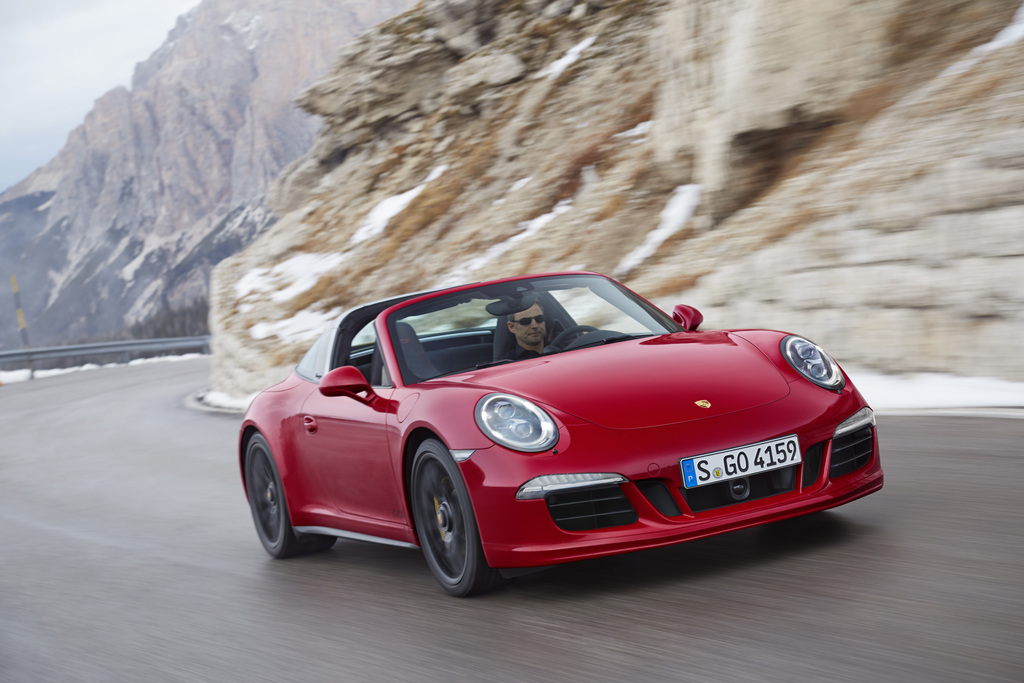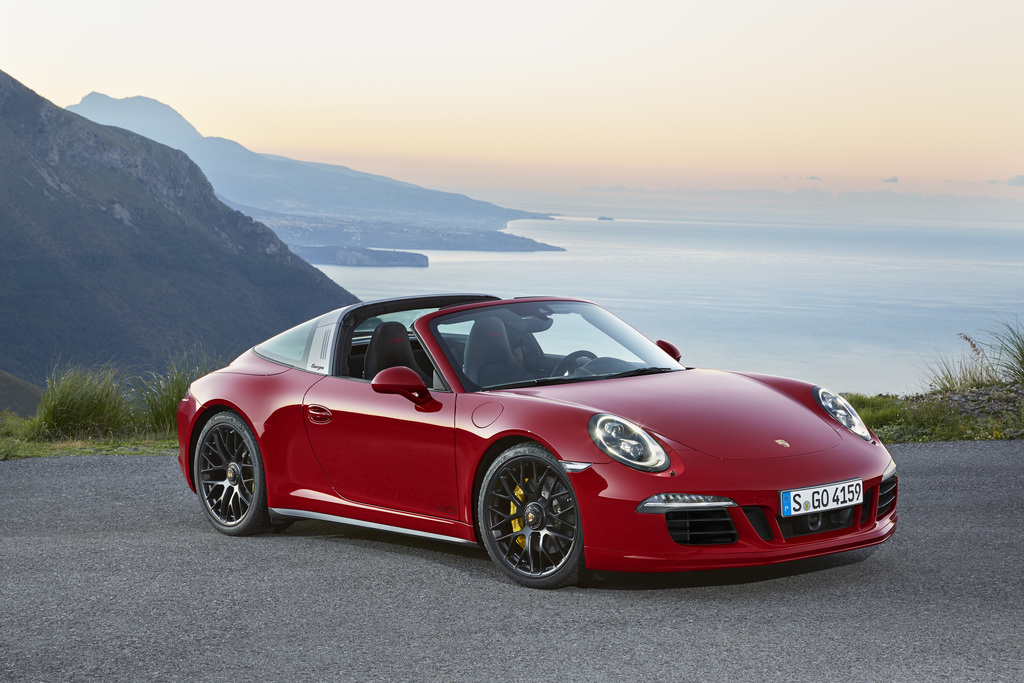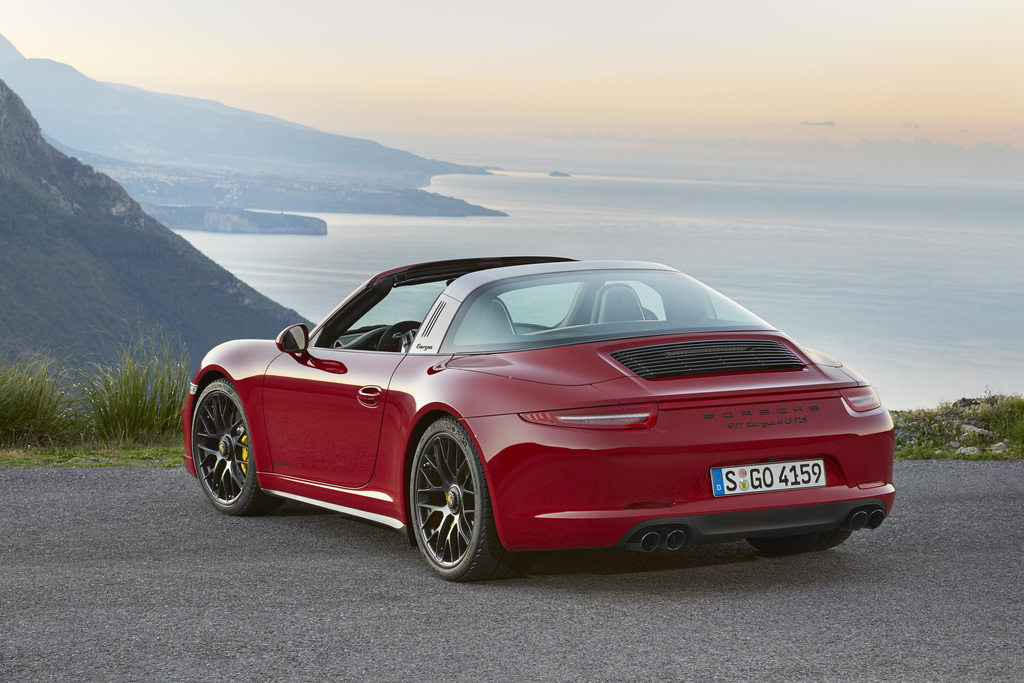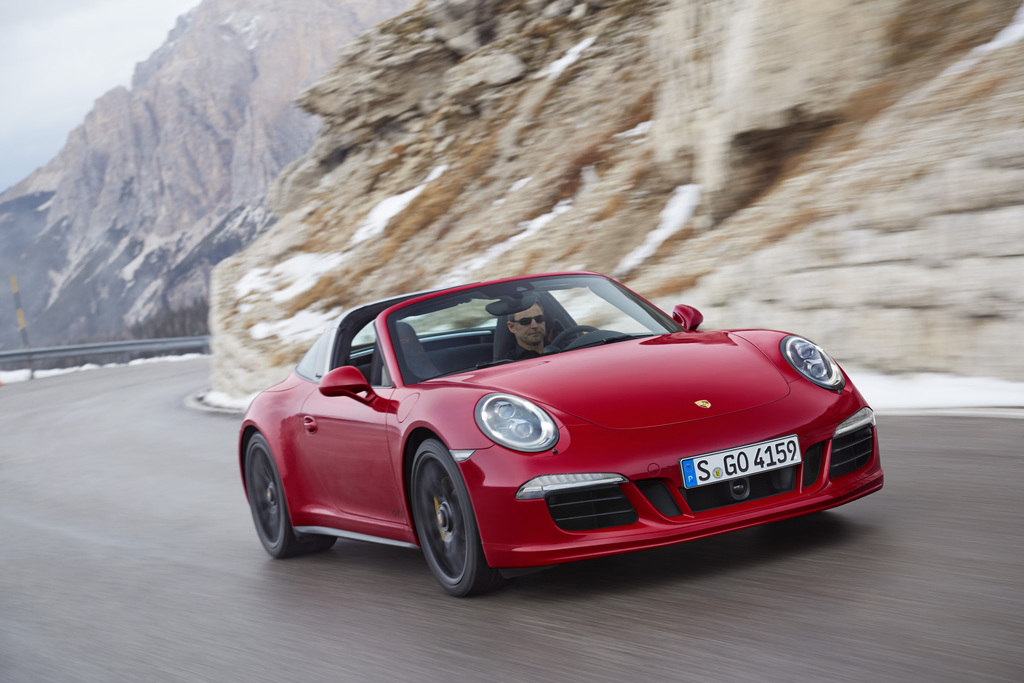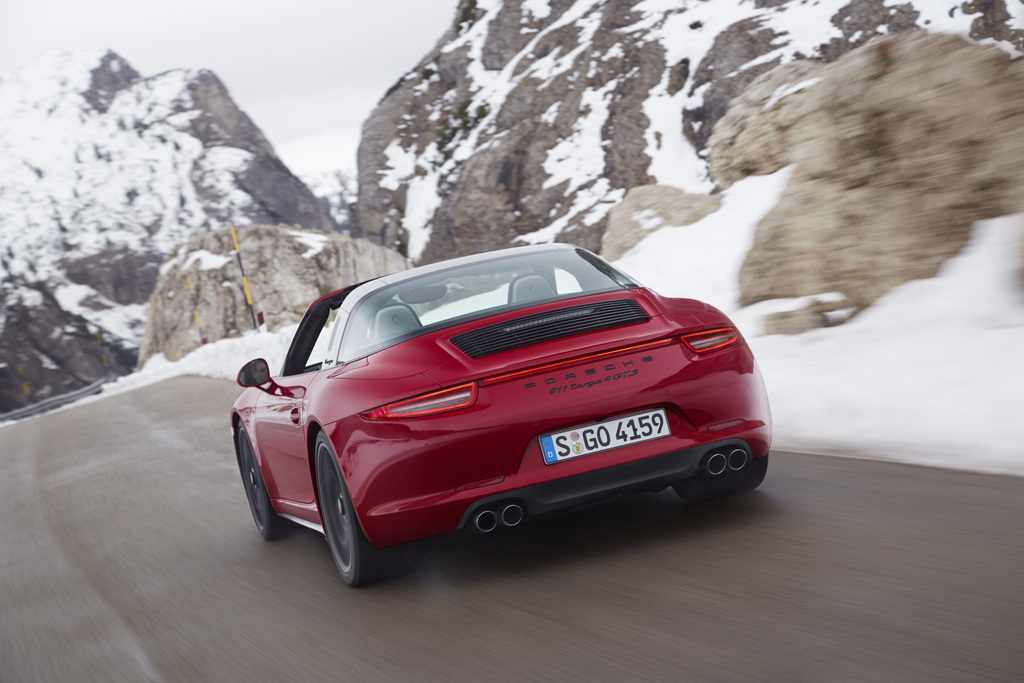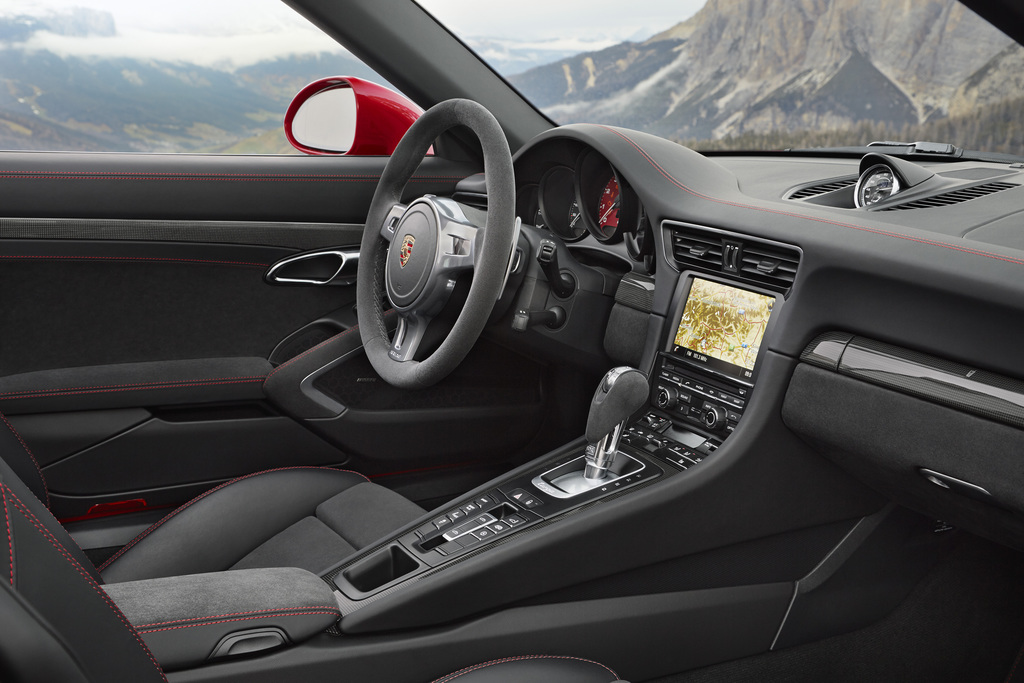(2015 – 2016) Porsche 911 Targa 4 GTS (991) – Ultimate Guide
With the 991-generation 911 Targa, Porsche got rid of the unpopular sliding glass roof panel and restored the Targa’s historical hoop-shaped silver rollover bar. The 21 year wait was worth it because it not only looks great but it is quite the circus act mechanical masterpiece in action when opening and closing. Just hold the switch, and the huge rear glass section lifts out of the way to allow a soft top to fold down behind the rear seats. The whole operation takes 19 seconds to open or close.
The newest 911 marked the 50th anniversary of the iconic Porsche 911 Targa and the first time a GTS version of the Targa bodystyle classic was offered as a model. It also brings the number of 911 variants to a record twenty-one, which may have a lot of people asking is there really a need for a GTS Targa. Good question, especially when you consider that the Targa 4 GTS is the most expensive normally aspirated member of the 911 family – pricier even that the hard-core GT3. Let’s see what you get for that hard earned money.
The GTS badge means this car is fitted with a collection of options that are available individually on the normal Carrera Targa 4 or Targa 4S. Like all GTS models across the entire Porsche line-up, the Targa 4 GTS gets more of everything, including more performance and more equipment, not to mention exclusive styling tweaks that clearly set it apart from its siblings.
For starters, the Targa 4 GTS gets Porsche’s a powerful non-turbo rear-mounted flat-six engine with 430 bhp @ 7500 rpm and 325 ft lbs of torque from 5750 rpm, driven to all four wheels via Porsche Traction Management. Performance is also enhanced via the standard Sport Chrono package, which provides faster throttle response and more aggressive shift mapping. In addition, the GTS benefits from Porsche Active Suspension Management – Porsche’s proprietary adaptive suspension system with continuously variable dampers. Mechanically, this is the perfect package for a daily 911 that is also performance focused when you need it to be.
Visually, the Targa 4 GTS differs from its ‘S’ sibling by its all-black highlights, including centre-lock 20-inch alloy wheels borrowed from the 911 Turbo, gloss black rear and side badging, rear engine cover and more serious looking quad exhaust tips. The GTS treatment also adds smoked headlight covers and the beautifully fashioned sport design door mirrors. It’s the same story inside, with the top-spec Targa gaining a weight-saving Alcantara-themed interior including the steering wheel, gear shifter, seat inserts, door trim and rear headliner. This special man-made material only weighs half as much as leather and is also used in Porsche racing cars. The distinctive GTS instrument dials, smoked aluminium trim strips and aluminium sill plates bearing the Targa 4 GTS autograph further lifts the driver-centric cockpit. It certainly feels more special than the standard Porsche Carrera.
On the performance front, the Targa 4 GTS is more than you could ever want in a road car. The 430 horsepower and 325 pound-feet of torque, on a vehicle that weights only 3,400 pounds means that it goes from zero to 60 in 4.1 seconds, and hits a top speed of 188 mph. The main “issues” with the Targa 4 GTS’s are limited to the car’s weight. Specifically, the massive wrap-around rear glass and motors to open and close it, making the Targa about 90 pounds heavier than the Carrera 4 GTS Cabriolet. While the coupe version of the GTS pulls hard during spirited sprints, you can feel a that the Targa is slightly slower.
Drive.com.au: Despite its obvious niche standing in the 911 range though, the Targa 4 GTS offers a unique breadth of appeal and capability with a style that’s all its own. It’s also one of the prettiest 911’s ever built – and due to land here in September.
It’s much the same story in the corners. Because the Targa is more softly sprung than other 911s, and because it has all-wheel drive, it’s not quite as exciting as you might imagine. It’s a long, long way from luxury GT softness, but it is someway off the Carrera GTS Coupe dynamically. Overall, it behaves brilliantly, carving up the mountain roads with precision and poise, while providing an exhilarating open-air driving experience, so we are being a little nit-picky here with the concerns. On the upside, the mechanical grip and sheer traction from the split-sized (245/35-front, 305/30-rear) rubber and all-wheel drive system is nothing less than prodigious. The end result is that you are able to get on the throttle earlier and enjoy stunningly quick corner exit speeds.
Pictures
Press Release
To mark the 50th anniversary of the 911 Targa, Porsche is offering this very popular model in the more powerful and dynamic GTS version for the first time. The targa concept of the 911 Targa 4 GTS delivers very safe driving enjoyment with all-wheel drive and a rollover protection bar; it also delivers open-air fun with a targa top that stows fully automatically.
Contributing to a boost in dynamic performance are the 430 hp (316 kW) GTS engine together with the standard Sport Chrono package, PASM chassis, 20-inch wheels and a sport exhaust system.
Despite its significantly extended features, the weight-to-power ratio with the 430-hp engine was improved from 3.9 kg to just 3.6 kg per horsepower compared to the S model. This lets the Targa 4 GTS reach a top speed of over 300 km/h (186 mph) with a PDK transmission, and the stopwatch records 4.3 seconds for the sprint from zero to 100 km/h (0 – 60mph in 4.1 seconds). Although the engine produces an additional 30 hp (22 kW), its combined fuel consumption – which ranges from 9.2 to 10.0 l/100 km, depending on the type of transmission – is exactly the same as for the 911 Targa 4 S.
The latest Targa can be made out at first glance as a GTS model with all-wheel drive, because – compared to the two-wheel drive 911 Carrera models – the rear wheel arches are flared an additional 22 millimeters, and the rear tires are ten millimeters wider. The front view is defined by the sport design of the car’s front end with an opening for the auxiliary middle radiator and the smoked bi-xenon headlights that feature the Porsche Dynamic Light System (PDLS). In a side view, characteristic GTS attributes are the silky gloss black 20-inch 911 Turbo S wheels with central locks, the sport design door mirrors and “GTS” signatures on the doors. The “targa” logo on the silver rollover protection bar is also painted in silky gloss black. Black accents at the rear are the glossy trim on the air inlet screen, the model logo and the chrome tailpipes.
GTS DNA also defines the interior of the 911 Targa 4 GTS. Integrated at the center of the instrument panel is the stopwatch of the Sport Chrono package. In the front, the four-way adjustable Sport Plus seats – with their black GTS logo on the head restraints – provide additional lateral support and long-distance cruising comfort for driver and passenger. The dominant interior material is black Alcantara, which is just half the weight of leather.
The targa has been an established member of the 911 lineup since it made its debut back in 1965. Around one out of eight 911 cars ever sold was a targa. The market share of the latest generation of this exquisitely styled 911 with its characteristic rollover protection bar is 13 percent – and it is growing. With the 911 Targa 4 GTS, Porsche is extending its lineup of the modern classic by adding a top model whose extensive package of standard features and price are appealing.
The Porsche 911 Targa 4 GTS will be launched in Germany from mid-March 2015. The price is 137,422 Euro including value added tax and country-specific features.


